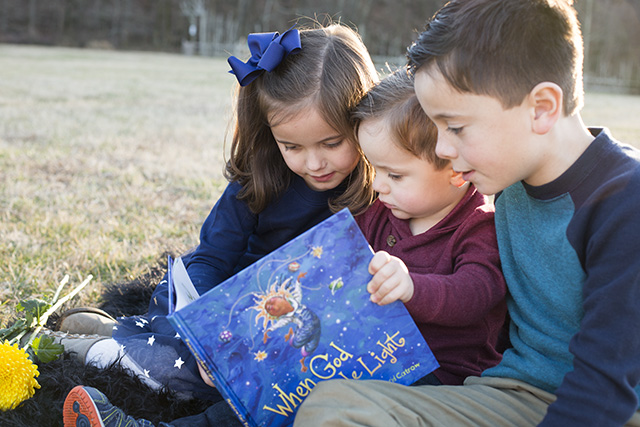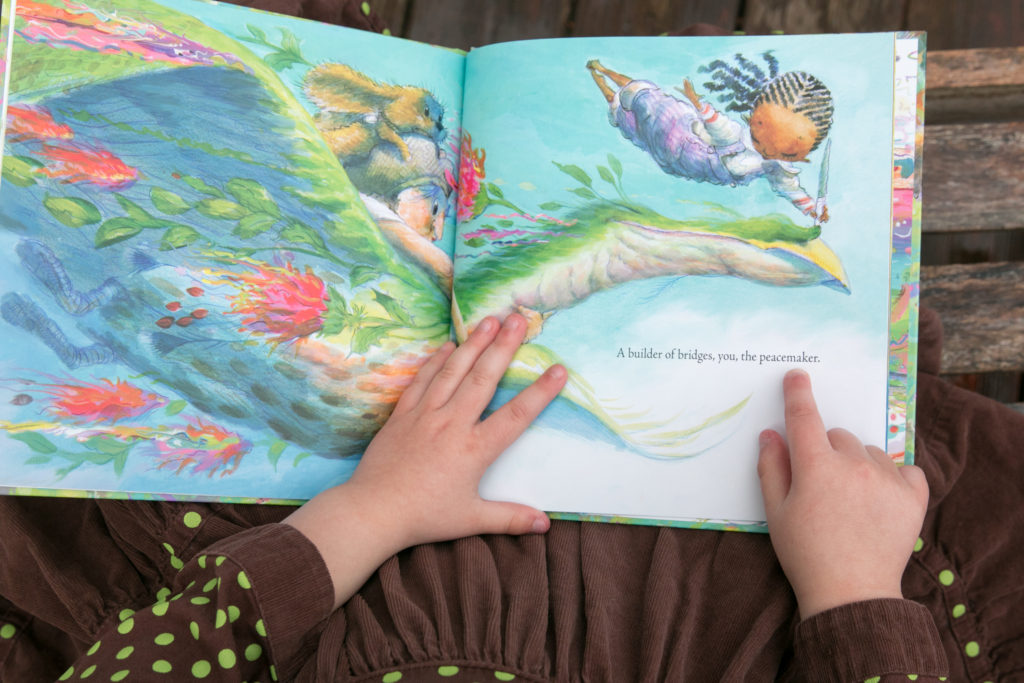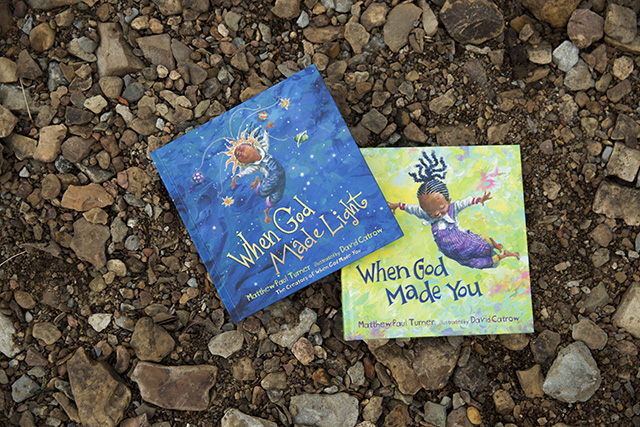Confession: The Problem with My Kids’ Bookshelves

When I became pregnant with Elias, I immediately started stocking his bookshelf with the classics. As he grew, so did his book collection. I unapologetically bought dozens and dozens of books for him – and later, for Adeline and Ezra – knowing the power of reading on a child’s development.
I’m ashamed to admit that I never really thought about how the books on our shelves reflected the diversity of the world. I bought what I knew, what I saw on Instagram and what Amazon told me I would like.
Then we released When God Made You, a book featuring a child of color on the cover. As we prepared for the launch, I read this startling statistic: 80% of the characters in children’s books are white. As I looked to our own bookshelves, I realized how much they lacked in diversity. I immediately set out to change that, buying a multitude of diverse books that more accurately reflected the world.
Matthew and I have been overwhelmed with feedback from people of color thanking him for publishing a book that had a main character that looked like their child. As somebody who has never walked into a store and not seen my kids represented on the covers of children’s book, this last year has been eye-opening and humbling.

What we didn’t expect was how many white people would say things like –
I bought your book for a family I know that was adopting. It was perfect for them. Why wasn’t it perfect for your family?
Will your next book have a white main character? No. Why should it?
Maybe could you offer When God Made You featuring different ethnicities for people to choose from. Is this a joke?
I’m not making this up. Truly, it’s been horrifying. I have thought about writing about it numerous times, but the topic felt big, important and I worried about messing up the words. With When God Made Light releasing next week, I’ve been thinking about this topic a lot again. I believe God will use this book, only as he can, to encourage all kiddos of all skin colors.
Here’s what I know and what I want to be sure you know: As parents, we must ensure that our family’s children’s books reflect diversity. Diversity in ethnicity, gender and situation. If your child’s books are full of white boys and girls, that needs to change.
Immediately.
Go to the library and challenge yourself to only check out books that don’t feature white main characters. Head to Amazon and fill your cart up. Do something to change this statistic. Teach your children empathy by reading diverse books with characters who don’t look like them.
The world needs parents who do that with intention.

Preorder When God Made Light this week and get When God Made You free. Details here.
For more on this topic, read:
Kids Need Diversity in Books to Prepare Them for the Real World (Newsweek)
Why Young Children Need Diverse Books (No Time for Flashcards)
The We Need Diverse Books Organization
Book Lists
20 Picture Books with African American Girl Characters

Great topic, and so very true! Having a girl, it’s a similar situation with her dolls – why do they all have to look just like her? We’ve gotten her dolls of different colors and we get questioned on it and I think, “Why can’t a white girl have a black doll just because she loves it?!” Come on folks, let’s not be so narrow minded. This is a great point on books, I am going to absolutely look at diversifying ours as well!
Great topic, and so very true! Having a girl, it’s a similar situation with her dolls – why do they all have to look just like her? We’ve gotten her dolls of different colors and we get questioned on it and I think, “Why can’t a white girl have a black doll just because she loves it?!” Come on folks, let’s not be so narrow minded. This is a great point on books, I am going to absolutely look at diversifying ours as well!
Yes! My daughter has Barbies and dolls of all races. Kristen Howerton wrote a great post about this. http://www.rageagainsttheminivan.com/2016/01/two-white-girls-get-black-dolls-for.html
In it, she says, “But it’s also a reminder of how easily children can pick up on racial bias. It’s easy to think that devoid of a racist parent, no children would ever behave this way. That racism is a learned behavior. And while I do believe that racism is learned, I also believe that our children are ALL growing up in a society in which they are swimming in racial bias. And if we want to avoid our white children being disappointed in a black doll, we have to be very intentional to overcome societal norms that suggest to our children that they should appreciate white skin over brown… And really, buying diverse dolls is just the tip of the iceberg in raising a generation that will bridge the racial gap in our country. There are so many bigger things we should be doing as parents, including making sure our community and the people in our lives and in our homes reflect the diversity that we supposedly value. But the dolls . . . I mean, buying diverse dolls is so easy. It takes so little effort. And it’s so important.”
Thank you for admitting this. It is hard to do. I struggle with a lotof industries refusing to represent non-white people. When I bring up the lack of diversity to scrapbookers I get icy responses at best. Everyone means well. But no one wants to actually change.
I love that Matthew’s books featured a child of color on the cover. I have so much trouble finding diverse books for my kids! When I have asked people for advice I often get told to pick up Snowy Day. That book is over 50 years old!! I need more than one option.
I have found a few gems over the years and thought you might like this list also: http://avinashhecker.blogspot.com/2017/03/we-need-diverse-books-10-amazing-books.html
Thank you for sharing this list. I added a Year Full of Stories to my cart!
Thank you for this post, Jessica.
I couldn’t agree more! I’ve been reflecting a lot on the idea of white privilege lately. I think a couple years ago I would have thought that was an outdated problem. But it is not. This past year I feel like I am slowly starting to understand that more fully–as much as I can being white. I love reading with my 2-almost-3-year-old daughter. And she loves all books regardless of the character’s age, race, or gender. In fact, she went through a phase a few months ago where her two favorite books were Jack Keat’s Snowy Day and Maggie and the Pirate (which is a sad book–at least from an adult perspective). She adores “When God Made You”–we bought it for her when her brothers were born this past year. I can’t wait to get “When God Made Light”. 🙂 Her two best friends are Asian and I don’t think she has noticed skin color one bit, but she has learned to respect their culture more by taking off her shoes when we go over, eating food/flavors that are new to her, etc. I think being able to acknowledge and respect differences in culture is huge. And then sooner we allow our children to learn to do that, the better. I am still learning that as an adult. Her friends’ mom and I are often asking each other questions about our background to understand more because she moved to LA from Vietnam as a kid and her family is Buddhist, though she is now a Christian. And I grew up in a white, Christian family in Nebraska.
So very thankful for the books, for honest posts like these, and for thoughtful leaders like you both. My book is a creative retelling of the Noah’s ark story, and, while Noah doesn’t actually have a huge part in the book, it was important for me to portray him as he probably looked: with dark skin. In one of my first school readings, a little girl asked why Noah’s skin was dark, and I was really happy to answer that question for her. Kids notice! Here’s a link to the book, if you’d like to take a look: https://www.amazon.com/gp/aw/d/0692943625/ref=cm_cr_arp_mb_bdcrb_top?ie=UTF8
I’ve got both of Matthew’s books ordered. Can’t wait to share them with my children.
I own both of your books and the first thing I appreciated WAS the diversity of the characters. We are a white family from the Midwest, where celebrating diversity isn’t always a top priority. I want my sons to have a realistic worldview, where they celebrate those that don’t look like them. The world is made up of so many beautiful people. Thank you for creating a book that gives us a glimpse at the beauty of diversity.
When our son was 4 and I was expecting our second, people would as if we knew if we were having a boy or girl. His response: “we don’t know if it will be a boy or a girl or what color it will be.” (You see, we worked in a multicultural neighborhood and his best friend was of Latin descent. I loved it!!) My children grew up where eye shapes were as diverse as skin tones. As adults, currently my grown married children both live abroad with their families. Praise Jesus!
We live in what is considered the most diverse city in the nation; still issues, lack of understanding,lack of representation of that diversity. We are all biased, some biases are more problematic than others and not all are expressed negatively. We specifically sought more diverse books after my daughter’s heart was broken her first year teaching when a first grader said she was pretty because she has white skin. Thank you for your heart for all God’s beautiful children, for raising this issue and providing resources!